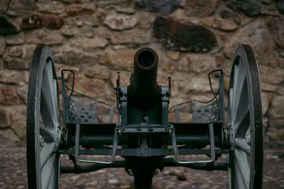Design as a Weapon

Photo by Robin Edqvist on Unsplash
I have just watched the movie, Napoleon. In one of the earlier battles, Toulon, Napoleon's team re-cast a trusted weapon to a new form to fit the new battle circumstances. Sure, they could have just used the old, trusted cannons in greater concentration or a new configuration but the choice to make a bold, tactical change was the right one and the battle was quickly won.
Many businesses have teams and budgets driving more and more bought, ’qualified’ traffic to their digital assets. It is the task of the digital assets to convert this expensive traffic. That might be a form, a request for information, a registration or, yes, a purchase.
So, the reality is the digital ‘experience’, we’ll use the website as the example, does the heavy lifting. Likely, this website has been A/B tested for several years, page by page, it has personalisation’s across it and data flowing from it to a repository, active or passive. BUT the underlying design, layout et al, was turned live 2, 3, maybe 4+ years ago. Frankly it is now looking almost exactly like its competitors.
So, design, while not given urgency and not examined regularly is the most likely to be the weapon that better converts your expensive traffic. If, like me, you read widely on the topics around digital business excellence, you’ll have come across articles from Forbes or McKinsey on this very topic. Further great design can earn more direct traffic to convert. Better design equals better basic business outcomes.
Design, while it is NOT set and forget is also not ‘make changes every week’, there is a middle ground.
On the tech side, a lot has been written and discussed around the technical revolution that is “Headless“. The intelligentsia initially argued that Headless was a technology in search of a problem. Now, with the era of the Digital Experience Platform ( DXP ) or Composable Platforms, upon us, Headless has a bigger role to play. A Headless stack can be more flexible and offer options to plug in new shiny tech quickly, swapping out the old weapons.
For the CDO or CMO, and especially for the CFO, it is becoming more and more likely that there will be multiple vendors and multiple Subscriptions to manage, let alone multiple parties should there be a problem occur within this new tech stack. This is the flexibility and complexity of a headless stack.
But…let’s go back and look at the head. Now design CAN be de-coupled from the supporting stack, so more freedom and more possibilities. Some of the early headless designs didn’t really distinguish themselves from templated systems and were built on the best frameworks about at the time. Lots and lots of articles will expound the scalability, flexibility and security virtues of the headless architecture.
The business question now is more nuanced. Can CX/UX design be a weapon for business? Does design, in and of itself, have value? Bought, Earned and Retained: the three categories of traffic to your site. Better design can increase the conversion of Bought traffic. Better design can increase the volume and conversion of Earned traffic. Better design can increase the rate and conversion of Retained traffic.
Better design, then, IS a weapon. However, very few businesses in the avalanche of teams working on Business-as-Usual have either the time, nor skills to get to it and do it well. It isn’t easy and it requires user/stakeholder engagement. It isn’t easy but it is necessary. If our friend Napoleon went the easy path and stayed with Business as usual, he might not have had extraordinary, repeated successes.
Design is a Weapon